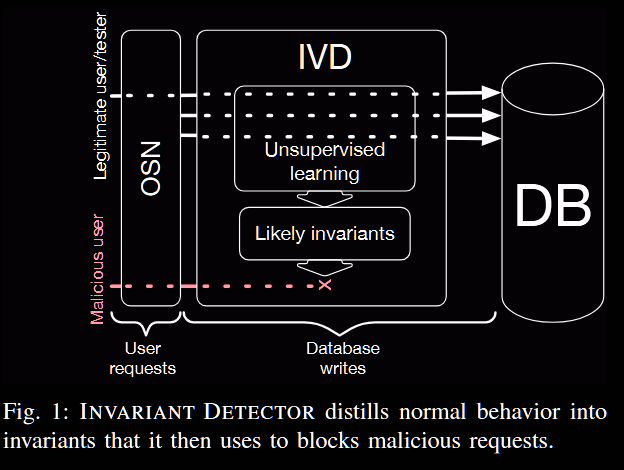Collaboration with Facebook engineers to develop a tool that prevents malicious HTTP requests from accessing sensitive resources in large-scale web applications. Likely invariants are automatically identified from testing or pre-release stages to prevent authorization bugs. White-box approach that sits between back-end code and database
Front-end software role in HTTP requests tampering:
- Bypass of client-side authorization checks: sometimes the web server logic processes HTTP requests assuming information that depends on client-side authorization checks, which can be bypassed
- API discovery: legitimate use of the web application allows an attacker to understand the arguments of requests and subsequent responses. The threat model considers the presence of a regular user account, and a user who is logged in or logged out). This can be a manual trial and error process, or can be automated
Context
In very large scale web applications (e.g., online social networks), many types of user interactions, with different levels of permissions coexists (user, group administrators, business, etc).
- Manually maintaining and enforcing RBAC (role-based access control) rules is complicated and human errors are possible, especially with time and resource constraints
- many parameter tampering opportunities are possible in a very large scale web application
Authorization bugs: can lead to identity theft, data leakage, business losses, brand reputation damage.
- auth bugs are among OWASP top 10 vulnerabilities and are very easy to exploit
Contributions
- A scalable distributed dynamic invariant detection system for highly interconnected data
- A two-step invariant generation mechanism and a set of design and implementation choices that allow the system to scale and to achieve negligible runtime overhead
- A set of domain-specific enforcement excuses that tackle the inherent susceptibility to false positives of invariant detection systems
- Results showing that dynamic invariant detection can effectively identify incorrect authorization checks and prevent attackers from exploiting them in a real-world OSN
Approach
- Invariant Detector (IVD) provides a safety net against missing or incorrect authorization checks, supporting the developer’s job
- It mines likely invariants from legitimate database writes, and blocks HTTP requests which break existing invariants
- IVD has a short learning period, usually covered by internal testing, dogfooding, or a pre-release period, making it ready to act by the time a new product feature is made available to users
- IVD adapt automatically to the application growth, by continuously learning invariants with no manual intervention
- Our white-box approach infers invariants at the database layer, allowing more expressiveness and unprecedented scalability
- Bugs detected and blocked by IVD are possibilities for new authorization rules

Writing and reading a graph database Database writes and reads can happen before or after an authorization check:
- in database writes, the authorization check is performed first, then the write command is executed
- in database reads, the read command is executed first, then the authorization check is performed (the property to be checked is contained in the object actually stored in the database)
- database reads are therefore several orders of magnitude more frequent than writes
- for this reasons, IVD focuses on write operations on a graph database
Identification of invariant (Invariant Learning phase) IVD uses an unsupervised learning process to infer invariants:
- The process is based on observing the normal behavior of the social network, in particular the database writes resulting from requests from legitimate users or testers
- IVD intercepts requests between the OSN and its database
Request Sampler Samples a (configurable) number of requests for each “invariant category” (defined by endpoints, entity types, and operation). Records the request and local and global property values at the time of the database request. Samplers are distributed and stateless, but synchronize sample rates. An external component periodically adjusts sample rates.
Invariant Inference Engine The invariant inference engine looks for patterns in the data logged by the request sampler, by working offline. It breaks down logs by invariant category and analyzes each category separately:
- identifies sets of local and global properties that are always the same (equality invariants) or associations that always exist between related objects (association existence invariants) across all requests sampled for a given category
- The inference process is autonomous and resilient to workload changes or temporary failures
Invariant Checker The invariant checker sits between a client and the database system, similarly to the request sampler. It runs synchronously on all database requests. For each database request:
- it retrieves the endpoint that made the request and the involved entity types to determine the invariant category for the request
- it then uses the category to get all relevant invariant predicates. The predicates are evaluated and any violations are logged
- if a ratified invariant is violated, the database request gets aborted and an application exception is thrown
Evaluation
IVD was deployed at Facebook in 2015 and has since detected several critical vulnerabilities that have since been fixed
- average overhead of 1-2 milliseconds
Limits
Few false negatives were found:
- IVD was not able to report a bug that allowed a user could delete a video posted by other users. Not enough data were available for the model to learn the right invariants in this scenario
- Too complex invariants are difficult to detect